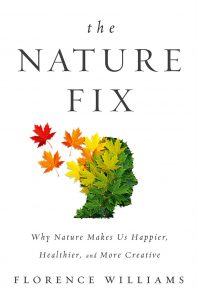The Nature Fix
Posted in From the Library on January 30 2017, by Esther Jackson
Esther Jackson is the Public Services Librarian at NYBG’s LuEsther T. Mertz Library where she manages Reference and Circulation services and oversees the Plant Information Office. She spends much of her time assisting researchers, providing instruction related to library resources, and collaborating with NYBG staff on various projects related to Garden initiatives and events.
 Why do some of us feel happier, healthier, more relaxed, or more energized by nature? Why does an isolated hike in the woods illicit strong feelings of contentment, while a walk in an urban green space devoid of trees fails to inspire the same feelings? Different people have different reactions to time spent in nature, of course, but why do we have reactions at all? Why are some people more affected than others by a babbling brook or a coniferous forest? With these big, somewhat subjective questions in mind, Florence Williams sets out on a journey to find and share answers in The Nature Fix: Why Nature Makes Us Happier, Healthier, and More Creative. The mix between personal and academic voice can be a tough thing for an author to navigate, but Williams accomplishes this hybridity with great skill.
Why do some of us feel happier, healthier, more relaxed, or more energized by nature? Why does an isolated hike in the woods illicit strong feelings of contentment, while a walk in an urban green space devoid of trees fails to inspire the same feelings? Different people have different reactions to time spent in nature, of course, but why do we have reactions at all? Why are some people more affected than others by a babbling brook or a coniferous forest? With these big, somewhat subjective questions in mind, Florence Williams sets out on a journey to find and share answers in The Nature Fix: Why Nature Makes Us Happier, Healthier, and More Creative. The mix between personal and academic voice can be a tough thing for an author to navigate, but Williams accomplishes this hybridity with great skill.
Williams, like other popular science writers, brings readers along for the journey as she researches how different cultures or organizations scientifically quantify health benefits related to nature. Does that sound like a lot to cover in one book? It most certainly is. One of the great strengths of Nature Fix is that the author includes an enormous amount of cited scientific research alongside her more personal travelogue. She is also skilled with setting a scene for readers, providing descriptions that are both visual and engaging.
Williams investigates cutting-edge research as she travels to fragrant cypress forests in Korea to meet the rangers who administer “forest healing programs,” to the green hills of Scotland and its “ecotherapeutic” approach to caring for the mentally ill, to a river trip in Idaho with Iraqi vets suffering from PTSD, and to the West Virginia mountains where she discovers how being outside helps children with ADHD.
While curious, open-minded readers will find interesting topics of discussion and food for thought in Nature Fix, readers who approach this book already having the belief that nature is, in fact, a vital component in a healthy human life will likely have moments akin to a ‘religious’ experience or spiritual epiphany. Although scientific results are always open to criticism and debate, even doubters would be hard-pressed to dismiss all of the abundant hard data supporting the value of a nature fix for many people.
For those with particularly strong feelings about this connection already, Williams’s book will offer some practical ideas about why, where, and when a nature fix is most needed and beneficial. This book has much to offer to anyone interested in human health, from city planners and health practitioners to educators, scientists… and anyone concerned with their own well-being.

